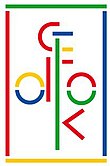GEDOK
The GEDOK , 1926 as " Ge Community D eutscher and O esterreichischer K ünstlerinnenvereine of all genres" founded, is a Federation of communities of artists and art-promoting e. V. to this day the oldest and Europe-wide largest network for artists of all genres.
Organization and goal
The federal association currently has more than 2,750 members in 23 regional groups in Germany. The federal association and the regional groups bring female art work in the fields of fine arts, applied arts / art design, literature, music and interdisciplinary / performing arts to the public and pursue the goal of promoting female artists and improving their special living and working situation. The non-profit association advocates the gender-equitable design of all areas of artistic creation as well as equal representation of committees and top positions in art and culture. The association of women artists is present in public through interdisciplinary art projects, exhibitions, concerts, readings, symposia, publications and catalogs. The association offers its artistically active members non-material and financial support through the commitment of its art-promoting members.
For members who promote art, the association organizes a variety of encounters with art and artists through visits to exhibitions and studios, workshop discussions, and art and cultural trips. The work of women artists is promoted through the awarding of prizes and award ceremonies, awards, grants and calls for tenders for competitions by the federal association and the regional groups. The following prizes are awarded for outstanding works: Ida Dehmel Art Prize of GEDOK and Gabriele Vossebein for fine arts, GEDOK FormART Elke and Klaus Oschmann Prize for Applied Art, Ida Dehmel Literature Prize and GEDOK Literature Prize . In the music division, GEDOK e. V. through concerts and competitions.
The GEDOK e. V. works proactively in awarding the Gabriele Münter Prize for visual artists and is the publisher of catalogs, documentations, anthologies and editions. The federal association is involved in national and international cultural institutions, political bodies and associations. B. represented in the following national and international organizations: International Society of Fine Arts , German Culture Council , German Art Council , German Literature Conference , German Music Council , Art Fund Foundation , German Women's Council .
The GEDOK e. V. is represented in the collecting society Bild-Kunst and in the jury for art in buildings of the federal government. In the above-mentioned bodies, the Federal Association works in terms of cultural policy in favor of the professional interests of women artists. Internally, GEDOK sees itself as a network and enables its artists to engage in intensive exchange and collaboration - across disciplinary and regional borders.
Founding history
The association was founded in 1926 in Hamburg by Ida Dehmel (1870–1942) as a "Community of German and Austrian female artists' associations of all genres". Ida Dehmel was a member of the Werkbund and on the board of the first Zonta Club. It was not only here that she stood up for women's rights. In particular, she promoted female artists by setting up a network of committed patrons to support them. In 1927 the GEDOK Niedersachsen- Hanover was founded in Hanover , in 1929 the Cologne group was founded under the chairmanship of Alice Neven DuMont , the GEDOK Heidelberg under the chairmanship of Elisabeth Pelissier and the GEDOK Karlsruhe. Shortly after the National Socialist seizure of power , Ida Dehmel was forced to resign from the board due to her Jewish origins in 1933 and was ultimately excluded from the GEDOK. Persecution by the National Socialist regime drove her to suicide in 1942. Of the 7,000 members at the time, 5,000 are said to have resigned in solidarity with Ida Dehmel. Elsa Bruckmann (member of the NSDAP ) was appointed as the new chairperson, and the female artists' association was renamed "ReichsGEDOK".
Shortly after the Second World War , the first GEDOK groups came together again: in 1945 in Stuttgart, 1946 in Hanover, Mannheim, Hamburg, in Cologne in 1947 and in 1948 in Heidelberg. In 1948 the GEDOK federal association was reorganized. The first constituent meeting took place in the house of Anna Maria Darboven on the initiative of Marianne Gärtner, Ida Dehmel's niece, in Hamburg. In 2010 the "Section Austria" dissolved until further notice. In 1990, after reunification, further regional groups were founded in the new federal states, including GEDOK Brandenburg, GEDOK Central Germany in Leipzig and GEDOK Mecklenburg-Western Pomerania, so that the association with its 23 regional groups now forms a functioning network.
Board
The headquarters of the Bundesverband GEDOK eV is Bonn (House of Culture), where its office is also located. The short board within the overall board with representatives of the artists and art sponsors consists of the president, the first deputy chairperson, the second deputy chairperson, the treasurer and the secretary. Ulrike Rosenbach acted as President of GEDOK from 2012 to 2018 . Her successor was Ursula Toyka-Fuong.
Non-profit status and admission requirements
The association is recognized as a non-profit organization. The members work on a voluntary basis. The association draws its financial resources from contributions and donations as well as project-related grants. A special feature is that not only artists from all sections, but also art-promoting members are accepted. Admission to the association takes place through the regional groups. A university degree is desirable for female artists, but qualified self-taught women can also apply. An expert jury in the regional groups decides on the admission of female artists.
See also
Web links
Individual evidence
- ↑ GEDOK. Retrieved April 1, 2019 .
- ↑ Award of the GABRIELE MUENTER PRICE, documentation, award of 1-2-3-4-5-6. Accessed in 2011 (German).
- ↑ Ruth Schneeberger: Frauenkunstverein "Gedok" - window to darkness. In: sueddeutsche.de. November 18, 2015, accessed March 1, 2016 .

